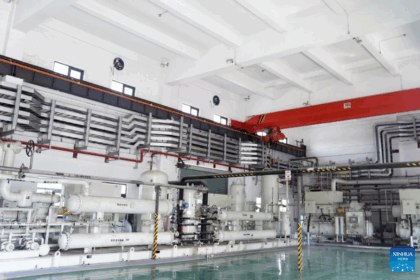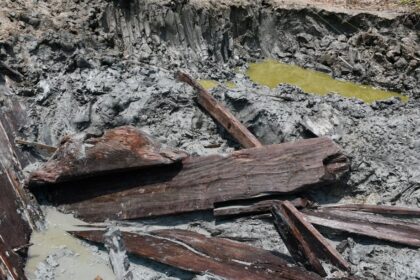China’s Shenzhou-20 Crew Achieves Second Spacewalk on Tiangong Space Station
China’s human spaceflight program reached another significant milestone as the Shenzhou-20 crew completed their second extravehicular activity (EVA), or spacewalk, outside the Tiangong space station. The operation, which lasted approximately six and a half hours, was successfully carried out by mission commander Senior Colonel Chen Dong and crew member Colonel Chen Zhongrui, while Colonel Wang Jie provided critical support from inside the station. This achievement not only demonstrates China’s growing expertise in space operations but also highlights the ongoing evolution of the Tiangong space station as a hub for scientific research and international engagement.
- China’s Shenzhou-20 Crew Achieves Second Spacewalk on Tiangong Space Station
- What Happened During the Second Spacewalk?
- Who Are the Shenzhou-20 Crew Members?
- What Is the Tiangong Space Station?
- What Tasks Did the Crew Complete During the Spacewalk?
- How Does This Spacewalk Fit Into China’s Broader Space Ambitions?
- What Scientific Research Is Being Conducted on Tiangong?
- How Does Tiangong Compare to Other Space Stations?
- What’s Next for the Shenzhou-20 Mission and Tiangong?
- In Summary
What Happened During the Second Spacewalk?
The second spacewalk of the Shenzhou-20 mission took place on June 26, 2025, beginning at 3:04 a.m. Eastern Time (0704 UTC) when Chen Zhongrui opened the Wentian module hatch. Chen Dong joined him two hours later, both donning advanced Feitian EVA suits. The pair worked outside the station for nearly 6.5 hours, returning to the Wentian science module at 9:29 a.m. Eastern (1329 UTC). Their tasks included installing debris protective shielding, inspecting and upgrading extravehicular equipment, and fixing components on the station’s exterior.
One of the most notable upgrades was the installation of automated foot restraint adapters and interface adapters on Tiangong’s robotic arm platform. These enhancements are expected to reduce the duration of future spacewalks by approximately 40 minutes, streamlining operations and improving astronaut safety and efficiency.
Li Xuedong, lead designer of the space station system at the China Aerospace Science and Technology Corporation (CASC), explained the significance of these improvements:
“In the previous spacewalks, astronauts had to install foot limiter and operation platform on the robotic arm’s end effector before and after exiting the module, and then rely on the arm to transport them to the work site.”
With the new adapters, these time-consuming steps are now automated, allowing astronauts to focus more on mission-critical tasks during their limited time outside the station.
Who Are the Shenzhou-20 Crew Members?
The Shenzhou-20 crew consists of three highly trained taikonauts (Chinese astronauts):
- Senior Colonel Chen Dong: A veteran of China’s space program, Chen is on his third spaceflight and second command. He previously led the Shenzhou-14 mission, overseeing the arrival of Tiangong’s two experiment modules, Wentian and Mengtian. Chen has now completed five spacewalks, making him one of China’s most experienced spacewalkers.
- Colonel Chen Zhongrui: On his first mission to orbit, Chen Zhongrui is a former air force pilot who has quickly adapted to the challenges of spaceflight. His mechanical expertise and piloting skills have been instrumental in the success of the mission’s extravehicular activities.
- Colonel Wang Jie: Formerly an engineer with the China Aerospace Science and Technology Corporation, Wang provides essential support from within the station, managing systems and assisting with the coordination of spacewalk operations.
The crew launched aboard the Shenzhou-20 spacecraft on April 24, 2025, from the Jiuquan Satellite Launch Center in northwest China. They docked with Tiangong just six and a half hours later, beginning a six-month mission focused on scientific research, station maintenance, and international outreach.
What Is the Tiangong Space Station?
Tiangong, meaning “Heavenly Palace,” is China’s modular space station orbiting Earth at an altitude between 217 and 280 miles (340 to 450 kilometers). The station consists of three main modules:
- Tianhe (Core Module): Launched in April 2021, Tianhe serves as the main habitat and control center for the station. It features regenerative life support systems, propulsion, and docking hubs for visiting spacecraft.
- Wentian (Experiment Module): Added in July 2022, Wentian provides additional crew quarters, an airlock for spacewalks, and scientific experiment racks. Its five-meter robotic arm assists with module positioning and astronaut support during EVAs.
- Mengtian (Experiment Module): Launched in October 2022, Mengtian further expands the station’s research capabilities and living space.
Tiangong is designed to be continuously inhabited by at least three astronauts for a decade or more, supporting a wide range of scientific experiments in life sciences, microgravity physics, and new space technologies. The station is about 20% the mass of the International Space Station (ISS) but is equipped with advanced systems and modular expansion capabilities. China plans to add more modules in the coming years, potentially doubling the station’s size and research capacity.
What Tasks Did the Crew Complete During the Spacewalk?
During the second spacewalk, Chen Dong and Chen Zhongrui accomplished several key assignments:
- Installation of Debris Protective Shielding: To safeguard the station from micrometeoroids and orbital debris, the astronauts installed additional shielding on the station’s exterior.
- Inspection and Maintenance of Extravehicular Equipment: The crew checked the condition of various external systems, ensuring the continued safety and functionality of the station.
- Installation of Foot Restraints and Interface Adapters: These upgrades to the robotic arm platform will make future spacewalks more efficient and less physically demanding for astronauts.
- Repair and Replacement of Components: The astronauts fixed or replaced parts as needed, maintaining the station’s operational integrity.
All tasks were completed with support from ground controllers and the use of Tiangong’s robotic arm, which played a crucial role in transporting astronauts and equipment to various work sites on the station’s exterior.
How Does This Spacewalk Fit Into China’s Broader Space Ambitions?
The Shenzhou-20 mission is part of China’s long-term strategy to establish itself as a major player in human spaceflight. Since the launch of the first Tiangong module in 2021, China has rapidly expanded its capabilities, conducting regular crewed missions, spacewalks, and scientific experiments. The country’s space program has set several records, including the longest Chinese spacewalk (8.5 hours) and the most EVAs by a single crew (four during Shenzhou-15).
China’s approach to space station operations emphasizes self-reliance, technological innovation, and international outreach. The Tiangong station is the only operational space station independently run by a single nation, following the exclusion of China from the International Space Station partnership due to U.S. legal restrictions. Despite this, China has expressed interest in international collaboration, recently engaging with students and scientists from Hungary in a live “Tiangong Classroom” event.
What Scientific Research Is Being Conducted on Tiangong?
The Shenzhou-20 crew is engaged in a diverse array of scientific and technological experiments, including:
- Space Life Sciences: Studies on microbiota, nutrition metabolism, and bone health using advanced instruments like Raman spectrometers. Experiments with zebra fish and planarians aim to understand regeneration and the effects of microgravity on living organisms.
- Microgravity Physics: Investigations into the behavior of fluids, materials, and biological samples in the unique environment of low Earth orbit.
- New Space Technologies: Testing of regenerative life support systems, high-temperature superconducting materials, and intelligent robotics. The crew interacts with “Xiao Hang,” an intelligent spaceflight robot, to explore human-robot collaboration in space.
- Biotechnology: Experiments with streptomyces bacteria to assess the impacts of microgravity on microorganisms and prepare samples for further study on Earth.
These experiments not only advance scientific knowledge but also lay the groundwork for future long-duration missions, including potential lunar and deep space exploration.
How Does Tiangong Compare to Other Space Stations?
While Tiangong is smaller than the International Space Station, it is equipped with state-of-the-art technology and designed for modular expansion. The station’s three-module configuration provides ample living and working space for its crew, with advanced life support and robotic systems enhancing mission efficiency. China plans to add more modules and a large space telescope, Xuntian, which will share Tiangong’s orbit and dock for maintenance. Xuntian’s 2.5-billion-pixel camera will survey 40% of the sky over a decade, supporting astronomical research on an unprecedented scale.
Unlike the ISS, which is a joint project involving the United States, Russia, Europe, Japan, and Canada, Tiangong is operated solely by China. This independence allows China to set its own research agenda and mission schedule, while also opening the door to international partnerships on its own terms. The station’s continuous occupation and regular crew rotations demonstrate China’s commitment to maintaining a permanent human presence in low Earth orbit.
What’s Next for the Shenzhou-20 Mission and Tiangong?
With two months already spent aboard Tiangong, the Shenzhou-20 crew will continue their six-month mission, conducting nearly 60 experiments and technology demonstrations. Upcoming activities include further spacewalks, maintenance tasks, and educational outreach events. On the ground, preparations are underway for the launch of the Tianzhou-9 cargo supply spacecraft, which will deliver fresh supplies and equipment to the station.
China’s human spaceflight program is also looking to the future, with plans to expand the Tiangong station, train new astronauts (including the first from Hong Kong and Macao), and develop the Mengzhou spacecraft for larger crews and potential lunar missions. The country aims to land astronauts on the moon before 2030 and establish a sustained lunar presence through the International Lunar Research Station (ILRS) project.
In Summary
- The Shenzhou-20 crew completed their second spacewalk outside the Tiangong space station, marking a major milestone for China’s human spaceflight program.
- Mission commander Chen Dong and Chen Zhongrui spent 6.5 hours outside the station, installing debris shields, upgrading equipment, and enhancing the robotic arm platform.
- These improvements will make future spacewalks more efficient and safer for astronauts.
- The Tiangong station continues to serve as a platform for advanced scientific research, technological innovation, and international outreach.
- China’s space program is rapidly advancing, with plans for further station expansion, new astronaut training, and ambitious lunar exploration missions in the coming years.












